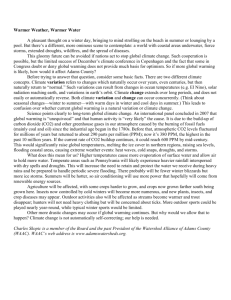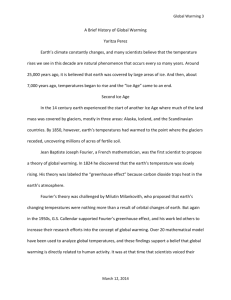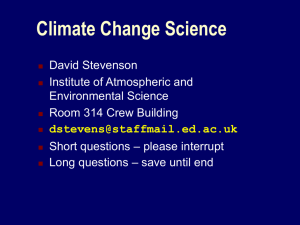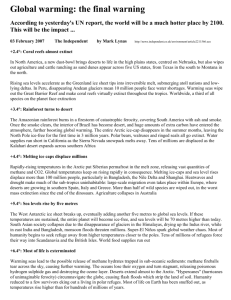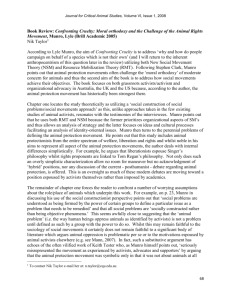Global Warming Activists Ignore the Science They Claim to Support
advertisement
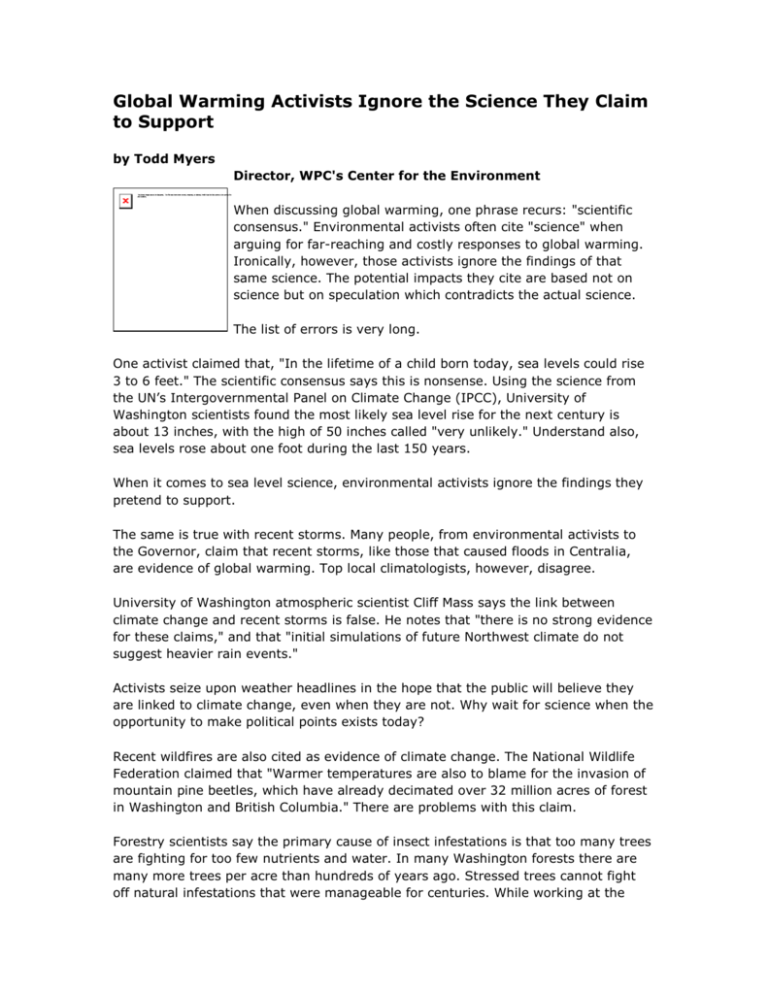
Global Warming Activists Ignore the Science They Claim to Support by Todd Myers Director, WPC's Center for the Environment When discussing global warming, one phrase recurs: "scientific consensus." Environmental activists often cite "science" when arguing for far-reaching and costly responses to global warming. Ironically, however, those activists ignore the findings of that same science. The potential impacts they cite are based not on science but on speculation which contradicts the actual science. The list of errors is very long. One activist claimed that, "In the lifetime of a child born today, sea levels could rise 3 to 6 feet." The scientific consensus says this is nonsense. Using the science from the UN’s Intergovernmental Panel on Climate Change (IPCC), University of Washington scientists found the most likely sea level rise for the next century is about 13 inches, with the high of 50 inches called "very unlikely." Understand also, sea levels rose about one foot during the last 150 years. When it comes to sea level science, environmental activists ignore the findings they pretend to support. The same is true with recent storms. Many people, from environmental activists to the Governor, claim that recent storms, like those that caused floods in Centralia, are evidence of global warming. Top local climatologists, however, disagree. University of Washington atmospheric scientist Cliff Mass says the link between climate change and recent storms is false. He notes that "there is no strong evidence for these claims," and that "initial simulations of future Northwest climate do not suggest heavier rain events." Activists seize upon weather headlines in the hope that the public will believe they are linked to climate change, even when they are not. Why wait for science when the opportunity to make political points exists today? Recent wildfires are also cited as evidence of climate change. The National Wildlife Federation claimed that "Warmer temperatures are also to blame for the invasion of mountain pine beetles, which have already decimated over 32 million acres of forest in Washington and British Columbia." There are problems with this claim. Forestry scientists say the primary cause of insect infestations is that too many trees are fighting for too few nutrients and water. In many Washington forests there are many more trees per acre than hundreds of years ago. Stressed trees cannot fight off natural infestations that were manageable for centuries. While working at the State Department of Natural Resources, I spoke with many foresters and entomologists who demonstrated this very process. Ironically, until recently, the environmental community made this very argument. Arguing for a "natural" policy of letting forest fires burn, the Northwest Ecosystem Alliance said in 2001 that "Because we have vigorously enforced a no-burn policy in these forests, many have become clogged with thick clusters of trees that could easily explode into the monstrous conflagrations..." They have since changed their tune, not based on the science, but on politics. Warmer temperatures can increase infestation, but ignoring the role of overstocked forests, and opposing the thinning necessary to help those forests recover, demonstrates a commitment to science only when it is convenient. The threat to polar bears is another claim trotted out in a fact-free way. I spent a week in Barrow, Alaska one November, braving 30 degree below zero temperatures to see these truly magnificent creatures. I have a strong affinity for them. But we must not ignore the facts. Polar bear populations are higher today than during the last forty years. Many more bears are killed by hunters each year than by climate change. The belief that polar bears are drowning is based more on the cartoon segment of Al Gore's movie than on the reality of these notoriously strongswimming animals. One final claim is that climate change will have a dramatic impact on our mountain snowpack. Scientists have repeatedly rebutted the claims made by climate alarmists. Snowpack has actually increased since 1980, a period when temperatures were increasing. U.W. scientist Mark Stoelinga argues that increasing temperatures may impact snowpack, but that many other factors are involved. He notes that in recent decades, "We can't see the global-warming signature in terms of a decline in snowpack." Claims that, in the words of one environmental activist, "nearly 60 percent of the Cascade snowpack could be lost," are political, not scientific. There is a real risk from the increase in carbon-dioxide in the atmosphere. But a crisis mentality that relies more on fear than science is the surest path to costly solutions that fail to solve the real problem. The key question is, if some environmental activists have to rely on political distortions of the science, how sound can their arguments really be? Todd Myers is director of the Center for the Environment at Washington Policy Center, a non-partisan independent policy research organization in Seattle and Olympia. You can reach him at tmyers@washingtonpolicy.org.

